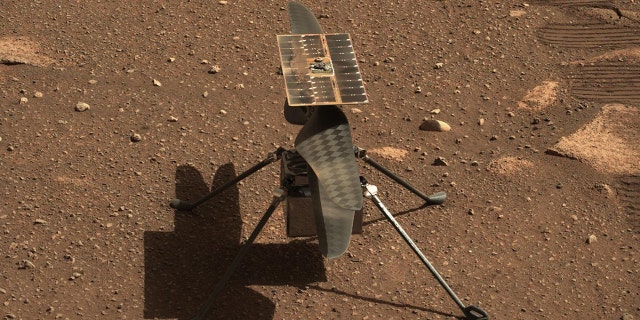2021 was a big year for air-and-space” target=”_blank”>space news<, space exploration was in the public spotlight.
Here are a few of the biggest moments:
February 18 — NASA’s Perseverance Mars rover lands on Mars
On Feb. 18, air-and-space fifth Mars rover, Perseverance, successfully landed on Mars’ Jezero crater.
“This landing is one of those pivotal moments for NASA, the United States, and space exploration globally – when we know we are on the cusp of discovery and sharpening our pencils, so to speak, to rewrite the textbooks,” then-acting NASA Administrator Steve Jurczyk said in a statement. “The Mars 2020 Perseverance mission embodies our nation’s spirit of persevering even in the most challenging of situations, inspiring, and advancing science and exploration.”
April 19 — NASA’s Ingenuity Mars helicopter flies
On April 19, NASA made history once again after its Ingenuity Mars helicopter completed the first-ever powered, controlled flight on another planet.
The helicopter hovered for 30 seconds at its planned altitude of 10 feet, and spent 39 seconds airborne.

NASA’s Ingenuity Mars helicopter is seen here in a close-up taken by Mastcam-Z, a pair of zoomable cameras aboard the Perseverance rover. This image was taken on April 5, the 45th Martian day, or sol, of the mission.
(Credit: NASA/JPL-Caltech/ASU)
NASA SPACECRAFT MAKES HISTORY, OFFICIALLY ‘TOUCHES’ SUN FOR FIRST TIME EVER
“Ingenuity has performed its first flight — the first flight of a powered aircraft on another planet!” flight control was heard saying in a NASA audio broadcast.
May 8 — Chinese rocket booster falls back to Earth
On the evening of May 8, the core stage of China’s Long March 5B booster re-entered planet-earth” target=”_blank”>Earth’s<.
After NASA Administrator Bill Nelson and others accused Beijing of acting recklessly, the Chinese government said it was unfairly being held to different standards than the U.S. and other space programs.
“We are willing to work with other countries including the United States to strengthen cooperation in the use of outer space, but we also oppose double standards on this issue,” Foreign Ministry spokesperson Hua Chunying said.
At the end of the month, the nation’s first Mars rover touched down on the planet and began to roam its surface.
June 2 — NASA selects two missions to study Venus
On June 2, NASA announced it had selected two new missions to Venus.
The VERITAS (Venus Emissivity, Radio Science, InSAR, Topography, and Spectroscopy) and DAVINCI+ (Deep Atmosphere Venus Investigation of Noble gases, Chemistry, and Imaging) missions map Earth’s nearest planetary neighbor and measure its atmosphere.
 Video
Video
DAVINCI+ will also determine whether the planet ever had an ocean.
They are expected to launch in the 2028 to 2030 timeframe.
HOW THE APOLLO 8 CREW DELIVERD AN OUT-OF-THIS-WORLD MESSAGE OF HOPE DURING A PIVOTAL CHRISTMAS
July 11 — Richard Branson reaches space in Virgin Galactic rocket ship
On July 11, Billionaire Richard Branson and five crew mates launched to space, flying more than 53 miles above the Earth in a final test mission before kicking off commercial space flights in the new year.
The 71-year-old became the first person to blast off in his own spaceship, beating Blue Origin founder Jeff Bezos by nine days.
November 15 — Russian weapons test threatens International Space Station (ISS)
On Nov. 15, a Russian weapons test created more than 1,500 pieces of space junk, threatening the astronauts aboard the ISS.
Nelson told The Associated Press at the time that he was “outraged” by the action and that it was “unbelievable that the Russian government would” do the test.
Secretary of State Antony Blinken said the test also threatened satellites.

This image made available by NASA shows an artist’s rendering of the Parker Solar Probe approaching the Sun.
(Steve Gribben/Johns Hopkins APL/NASA via AP)
Russian officials rejected accusations that they had endangered astronauts and Defense Minister Sergei Shoigu said the strike was carried out “with surgical precision.”
Astronauts now face four times greater risk than normal from space junk, according to Nelson.
December 14 — NASA craft ‘touches’ sun for first time
On Dec. 14, a spacecraft touched the sun for the first time.
CLICK HERE TO GET THE FOX NEWS APP
NASA’s Parker Solar Probe has flown through the sun’s corona, or its upper atmosphere, and sampled particles and magnetic fields there.
Scientists said it took months to get the data back and several more months to confirm.
Parker — launched in 2018 — was 8 million miles from the center of the sun when it first crossed the boundary between the solar atmosphere and outgoing solar wind.
The spacecraft dipped in and out of the corona at least three times.
Preliminary data suggests Parker also dipped into the corona during its ninth close approach in August, but scientists said more analyses are needed.
Parker will keep drawing ever closer to the sun and diving deeper into the corona until its grand finale orbit in 2025.
The Associated Press contributed to this report.









